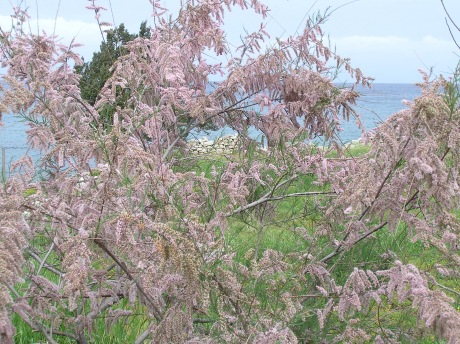zurück Rhodos
Blumen
last
Blumen 15
next

wilder Flieder Rhodos
Flieder
is the German word for lilac, a
popular flowering plant belonging to the
Syringa genus. Lilacs are known for their fragrant flowers and
beautiful appearance, commonly blooming in spring and early summer. Here are
some key features and information about the
flieder (lilac):
Key
Features of Flieder (Lilac):
1.
Appearance:
-
Flowers: The flowers of the lilac are typically
small, tubular, and come in
clusters. They are most commonly
purple or lavender
in color, but they can also be found in shades of
white,
pink, and
blue. The blossoms have a
sweet, distinctive fragrance that makes them highly popular in gardens.
-
Leaves: The leaves of the lilac are usually
heart-shaped or
ovate, with a
deep green color.
-
Growth Habit: Lilacs can
grow as shrubs or
small trees, with some
varieties reaching heights of up to
4-6 meters (13-20 feet), while others remain smaller. The plant has
a bushy or
spreading growth habit.
2. Habitat and Distribution:
- Lilacs are native to
Europe,
Asia, and
North America. The common
European lilac (Syringa
vulgaris) is the most widely cultivated variety, though many species
and hybrids exist.
- They thrive in temperate climates and
prefer areas with full sun
and well-drained soil.
Lilacs are typically hardy plants and can survive in colder climates, making
them popular in gardens in regions with
cold winters.
3. Blooming Period:
- Lilacs bloom in
spring, typically in
April or May, with
flowers lasting for several weeks. The timing of the blooms can vary
depending on the climate and specific variety of lilac.
- The blooming period is often
celebrated in many cultures as it marks the arrival of warmer weather.
4. Fragrance:
- One of the most beloved qualities of
lilacs is their strong, sweet
fragrance, which has made them a favorite in perfumes and floral
arrangements.
- The scent is most intense during the
bloom period, and it can often be smelled from a distance on warm spring
days.
5. Varieties:
- There are many different species and
hybrids of lilac, including:
-
Common Lilac (Syringa
vulgaris): Known for its classic purple flowers and powerful
fragrance.
-
Chinese Lilac (Syringa
chinensis): Often has smaller flowers and a more compact growth
habit.
-
Dwarf Lilac: These
varieties are smaller and often used for smaller gardens or container
planting.
-
Japanese Tree Lilac (Syringa
reticulata): This species has creamy white flowers and grows more
like a tree than a shrub.
6. Uses and Significance:
-
Ornamental Plant: Lilacs
are most commonly planted as ornamental shrubs in gardens, parks, and public
spaces for their beauty and fragrance.
-
Cut Flowers: Lilacs are
also popular as cut flowers
for bouquets and floral arrangements due to their attractive blooms and
pleasant scent.
-
Symbolism: In many
cultures, lilacs are associated with
renewal,
spring, and
fresh starts. In the
language of flowers (floriography),
lilacs often symbolize first love,
youth, and
innocence.
-
Medicinal Uses: In
traditional medicine, parts of the lilac plant were sometimes used for their
antiseptic and
anti-inflammatory
properties, although this is not common in modern herbal practices.
7. Care and Growing Tips:
-
Sunlight: Lilacs thrive
in full sunlight, and they need at least
6 hours of direct sunlight
each day for the best blooms.
-
Soil: They prefer
well-drained soil that is
slightly alkaline. If the soil is too acidic, lilacs may not thrive.
-
Watering: While lilacs
are drought-tolerant once established, they require regular watering in the
first year or two after planting.
-
Pruning: To encourage
healthy growth and abundant blooms, lilacs should be pruned after they
finish blooming, removing dead or damaged wood and shaping the plant.
In Conclusion:
Flieder (lilacs) are beautiful and fragrant plants that have become beloved
symbols of spring. Their vibrant
flowers and sweet scent
make them a popular choice in gardens around the world. Whether planted as a
shrub or enjoyed as part of a floral arrangement, lilacs bring both beauty and
fragrance to any space.
 26.07.25 Copyright Dirk
Rauschenbach Koelnerstrasse 293 51702 Bergneustadt
Datenschutzerklaerung 02261 9788972 Mail ccooly(
at) web.de
26.07.25 Copyright Dirk
Rauschenbach Koelnerstrasse 293 51702 Bergneustadt
Datenschutzerklaerung 02261 9788972 Mail ccooly(
at) web.de
 Safaris
Bergsteigen
Wandern
Inselwandern Weltweit
Safaris
Bergsteigen
Wandern
Inselwandern Weltweit
 Europa
Inselwandern
Europa
Inselwandern
 Städtewandern
Städtewandern
 Paintings
Paintings Dirk Rauschenbach
Dirk Rauschenbach
 Safaris
Bergsteigen
Wandern
Inselwandern Weltweit
Safaris
Bergsteigen
Wandern
Inselwandern Weltweit
 Europa
Inselwandern
Europa
Inselwandern
 Städtewandern
Städtewandern
 Paintings
Paintings Dirk Rauschenbach
Dirk Rauschenbach

![]() 26.07.25 Copyright Dirk
Rauschenbach Koelnerstrasse 293 51702 Bergneustadt
Datenschutzerklaerung 02261 9788972 Mail ccooly(
at) web.de
26.07.25 Copyright Dirk
Rauschenbach Koelnerstrasse 293 51702 Bergneustadt
Datenschutzerklaerung 02261 9788972 Mail ccooly(
at) web.de